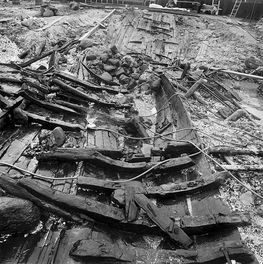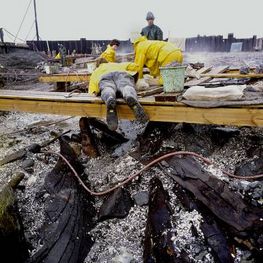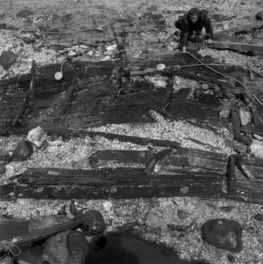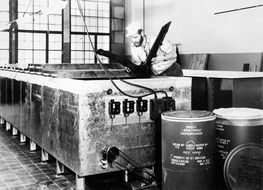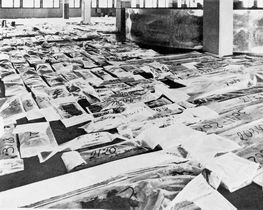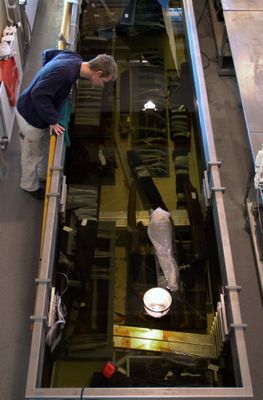Stories from locals
In cooperation with Roskilde newspaper we have called for great stories from local citizens - memories from the fjord, stories of visits to the excavation and experiences from the museum's first years.
Read the stories here:
Peberrenden, September 1962 by Jørgen Kjær, Jyllinge
At the end of the excavation we wanted to bury the last beer before sales tax was introduced. It had to be done in a proper manner. A note was written and placed aling with our 'last beer' in a plastic tube that was then welded at both ends. This was repeated several times to make sure it waas waterproof. A bag containing the tube was placed at the end of the excavation and marked with big rocks to create a small tomb.
When rolling rocks I didn't move my middle finger out of the way and it got stuck between two big rocks as they clashed together with a bang. My fingernail was poiting perpendicular from the finger with blood rushing out. I was dragged up to Ole Crumlin's office and sat down on a chair, but the two back legs of the chair broke (the others said I fainted). I woke up on the floor, had a cup of something strong (40% from Scotland), both to drink and on my finger, then a dressin for my wound and back to the excavation.
The last beer before sales tax is still out there, in the middle of the old excavation area, and the nail on my finger has been thin and weak ever since.
I found something exciting by Bjarne Lindegaard, Snekkerup
As a kid I sailed a lot on Roskilde Fjord. My granddad had a motorboat and during summer weekends we would sail on the fjord. We would dock in the small harbours or lie at anchor in the many beautiful bays around the fjord. My father and I would catch eels and shrimp from a dinghy we towed behind the motorboat when they were in season. We had a great family unit. At dusk we would sit on the boat's transom and peel shrimp.
One summer, when I was nine years old, we docked at the small harbour at Skuldelev. It was hot and the water was calm, so I sailed to the north side of Skuldelev near Peberrenden to catch shrimp. I knew beforehand that there were big rocks and seaweed here - a good place to catch shrimp. I succeeded in cathing supper!
On my way back to the dinghy that lay at anchor, I almost fell over something that, with a closer look, proved to be the stem from a boat or dinghy. I removed some rocks and when the water had cleared I saw a kind of snake or dragon head. I noted the location and rowed back to Ninon, which was the name of our 7-ton motorboat.
I told everyone what I had found and said that it would make a great hook in my room. Fourteen days later we visited the place again. This time I brought a saw. It was low tide and therefore I had no problem bringing the 'trophy' back home. My granddad mounted it on a board and put it up on the wall. I now had a nice, unusual hook for my gun belt and red cowboy hat.
After a few years I changed the interior in the room and the hook was, along with other things, put in the attic. Here was where I stored my cast-off toys. It gradually became messier in the attic and my granddad told me several times to clean things up. But since it was not the most exciting job, I took my time. One day when I came home from school my granddad had someone clean out the entire attic. It wasn't a tragedy, since I was no longer using the stuff.
A couple of years later I heard about the Viking ships at Skuldelev and suddenly I realised that the stem I had sawed off didn't belong to a homemade boat or dinghy, as I had thought, but to a Viking ship. The whole family is sad that it was gone.
Later in life I realised that it was a piece of cultural history that was lost. Today I recognise that it is an embarrasing story. It is, however, at the request of family and friends that read the newspaper article that I'm now writing this old story at the age of 68 - one might say the oldest story about the Viking ships.
A visit to Brede by Karsten Krabbe, Roskilde
As a high school student at Roskilde Cathedral School our class went on a trip to the art museum Louisiana, and from there we walked through the Deer Park to Brede (the Conservation Department of the National Museum).
Our teacher Michael Hauser had told us that it was a 12 kilometre walk - we laughed a lot and didn't believe him. But it was true!
At Brede there wasn't a lot to see, but it was still a historical visit. Inside some storage buildings we saw large tanks filled with thick pieces of ship timber. These were the planks from the Skuldelev ships, lying in a special bath where they were being hardened with a plastic-like substance, so later on they could survive in ordinary air without breaking. 'The water' in the tank was also heated.
I think I remember seeing other planks in clear plastic bags sealed at both ends. This was probably in 1967 or '68.
To be honest there wasn't a lot to see. Just some wooden planks in a large tank with fluid. But it does sink in when one visits the Viking Ship Museum 40 years later and sees the beautiful ships. You can sense the plastic-like membrane on the planks.
We didn't think a lot about the Viking Ship Museum itself. It didn't open until the school year of 1969 and by then Roskilde Cathedral School had moved out to the country, surrounded by bird songs and open fields.
A little story about my meeting with the Viking Ship Museum during the 1970s by Claus Hansen, Kbh. NV
I was a14-year-old boy interested in history and achaeology. This interest led to a job as an after-school and weekend custodian at the local museum in Grindsted, Jutland.
Once in a while a conservator from Ribe came to the museum. He supervised the collection of 'Jydepotter' - regional blck pots - and thought it was great that such a young boy was interested in archaeology. When he heard that I was going on vacation in Roskilde he offered to call the formerdirector of the Viking Ship Museum, Ole Crumlin-Pedersen, to introduce me.
On the agreed day I was to show up and introduce myself and then someone from the musum would take care of me. I came to the information desk and the called Ole Crumlin, who shortly after came and greeted me. I was shown around the exhibition and he told the amazing story of the excavation of the Viking ships.
At the end of this fantastic tour I was given a small sealed plastic bag with a piece of Viking ship the size of a coin. Ole Crumlin assured me that Danish history would survive the fact that this little piece of a Viking ship was privately owned in Grindsted.
Unfortunately, a few years later my curiosity made me open the bag and 'touch history'. The result was that my part of history crumbled and became dust. SORY!!!
